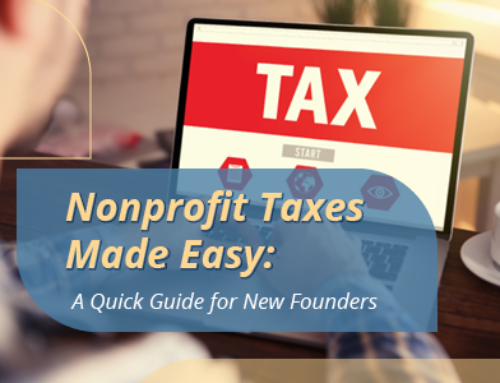With the ink barely dry on the new tax law, U.S. nonprofits are concerned about how it’s going to impact them.
This is the first major reform of the tax code in over 30 years. It’s complicated, and the potential ramifications are unknown.
Experts and officials are out there speculating about the effect on fundraising, but not a single person has the answer. Their advice for us is to keep an eye out on things as they progress.
I don’t know about you, but these wait-and-see dynamics are not good enough for me.
Here’s my advice: We can’t predict the future. We can only plan for it.
So don’t worry about what may or may not happen – stay focused on your dreams, your vision, and your goals.
People have been giving to charity since long before there were tax breaks. And most will keep giving now, whether they get a tax break or not.
Bottom line: Believe in what you’re doing and others will too.
Here are 5 nonprofit survival plans that will help you prepare for success in 2018 and beyond – regardless of what changes the new tax law brings.
1. Communications Plan – How you manage your nonprofit’s communications is critical to your success. Think about how nonprofits communicate to the outside world – newsletters, social media posts, brochures, fundraising events, press releases, and websites. And the list goes on! There are just so many ways to stay in touch with donors, and it’s critical that you do so.
A well-thought out Communications Plan can be your ally. Why? Because it provides a comprehensive way to ensure that your story is getting out, you’re representing your brand, and non-asks are consistently going out to your donor family.
If you’re looking for a starting point – or simply want to reassess your current communications – consider these key components to an effective Communications Plan.
- Audiences and Messages – Determine who you want to reach and what you’d like to tell them. Donors aren’t your only audience! What about volunteers, leaders in the community, and local media? They all respond differently to communications and understanding this can help you form the key messages you’d like your nonprofit to convey. This is called segmenting and it’s a smart move.
- Tactics and Timelines – When you communicate based on segments, it’ll be easier to share the right things (i.e. tactics). As mentioned, there are LOTS of ways to reach people nowadays. Be sure you’re connecting with them in the ways (and frequency) they like. Be intentional about when and how often your audience hears from you. Then, develop timelines around the tactics you choose to utilize to make this happen.
- Who’s Doing What – Figure out which person within your nonprofit is responsible for getting communications pieces out. Maybe that’s you! Or maybe your tech-savvy daughter manages your website and a board member speaks at fundraising events. The goal: ensure they know what strategies they’re carrying out and the timelines surrounding those related activities.
Tip! Do you have any public relations firms in your area? Sometimes, they provide pro bono services to nonprofits as a way to give back to the community. Dialing into an opportunity like this could save your nonprofit money and provide valuable expertise and resources.
2. Fundraising Plan – Many nonprofits struggle to create a fundraising plan and put it in writing, yet the benefits are tremendous. A written plan shifts you from being reactive and dealing with the crisis of the day to being proactive and working purposefully toward the results you want. Here are some questions to ask that will get you going in the right direction.
- How much money do we need to raise?
- Where will the money come from?
- Who will we ask?
- When will we ask?
- How much will we ask for?
- How will we follow up on a gift?
- How soon will we ask again?
Plan how, when, who, and what for every fundraising activity you undertake. And document it in your Fundraising Plan to guide your activities so you know where you’re headed. After all, if you don’t know where you’re going, any road will get you there (eventually).
Tip! Grab your B-HAG (Big Hairy Audacious Goal) and head over to our YouTube channel for How to Create a Fundraising Plan for Your Nonprofit.
3. Donor Plan – This one goes hand-in-hand with the Fundraising Plan, but the Donor Plan deserves a spotlight because using it to strategically build a broad base of financial supporters enables you to maintain a constant stream of income. Think of these individuals as valuable, caring partners – not just faceless, nameless sources of donations.
Active Donors: Stewardship is critical if you want to keep your current donors giving (and who doesn’t?). A current donor is 5 times more likely to give than someone who hasn’t given – if you do a good job balancing the asking with sharing and communication.
Good stewardship is about treating people like the valuable resource they are. It’s important no matter how big or small your organization is to treat every donor as if they are your most important one.
The best thing you can do is to continue to build relationships with your donors. Treat them like partners. Communicate regularly. Keep them in the know about what’s happening in your programs and the impact you’re having. Most importantly, tell them the stories about the lives that are being changed by your nonprofit’s work.
When you do that well, they’ll feel compelled to continue supporting you.
New Donors: Always be on the lookout for ways to grow your donor list. And add new names regularly.
Start by creating an Ideal Donor Profile to give you an idea of exactly who you’re looking for. An Ideal Donor Profile identifies the top psychographics and demographics of your best donor, so that you can go find more people just like them. Think about that: if you knew a few key details of your best donors, wouldn’t it make donor acquisition a lot easier?
It doesn’t have to be complicated to figure out.
Sit down with a blank piece of paper and think about your top donors. Jot down their names. What do they have in common? Think about their age, their sex, their education, and whatever else you can think of. Write each one down. If you can get at least 3-5 things, this will help.
Tip! Check out What Do Your Donors Want? to read more about how nonprofits can be crazy-successful with donors. It’s an oldie, but a goodie.
4. Volunteer Plan. Imagine if you had a team of passionate, results driven, and energetic repeat volunteers. Talk about being on cloud nine!
Think about it: when you surround your nonprofit with a lot of people who care about your work, you have a ready-made army of supporters. They’ll be there to carry out your work in an ongoing way because they care about the lives your nonprofit is changing.
It’s possible to find these gems by taking time to invest in a few critical steps found in strong Volunteer Plans.
- Recruiting – Create a list of “positions” within your nonprofit that a volunteer could fill. It’s ok to hang a sign on your door or post on social media that you’re looking for awesome volunteers to fill these spots. If you need someone with a specific skill set, be sure to advertise for that, too.
- Orientation and Training – It’s easier for people to succeed at a job if they have clear instructions, understand what’s expected of them, and have the tools to perform. Carve out time to welcome new volunteers and give them a rundown of your nonprofit. When they’re ready to dive in, share with them what you’d like them to accomplish. Also, introduce them to their “supervisor” – someone who can check in on them occasionally and be available if they have any questions, if that isn’t you. Making them feel comfortable and invited will go a long way.
- Appreciation – One of the most powerful motivators to keep people coming back and volunteering for an organization is meaningful service. If they feel like they’re making a difference in their community and enjoy the volunteer experience, they will come back time and time again. Acknowledge them and share with them details about the impact their work makes.
Tip! Volunteer positions can be posted with Points of Light, which is the nation’s largest organization dedicated to volunteer service. They help mobilize millions of people to take action and change the world.
5. Organizational Strategic Plan – Strategic planning provides an opportunity for you to consider your nonprofit’s future; it sets the direction for where you’re going in the next few years; and then it documents how you’re getting there. The resulting product is a strategic plan, and using this framework, along the way, enables nonprofits to make strategic decisions about programs and initiatives without getting lost (commonly referred to as “mission creep”).
Although lots of nonprofits approach strategic planning as a facilitated process with months of planning and lots of people involved, it doesn’t have to be that complex.
An effective bout of strategic planning requires you to do a few things. For one, you must step away from the hustle and bustle of the everyday operations of your nonprofit. Two, you set aside time to put your head together with a few different people who know your nonprofit pretty well – board members, employees, volunteers, clients, and donors, for example. Then, you take time as a group to collectively explore questions like the ones listed below.
- What is our vision?
- What is our theory of change?
- What role are we playing in this social challenge we’re addressing?
- How does our mission get us there?
- How can we make a BIGGER difference?
- How will we succeed in what we want to do to affect this BIGGER change?
- How are we going to measure our success?
- What capabilities – skills, resources, etc. – do we need to create the impact we’ve set out to achieve?
A plan is only as good as its execution. You’ll need to refer back to the plan frequently in order to monitor progress being made, assess and make any adjustments and updates, and celebrate successes along the way.
Tip! Keep your Strategic Plan handy. Funders and donors are becoming increasingly more interested in these and sometimes ask to review them.
Additional resources:
The Council of Nonprofits recently conducted an information webinar – Now What: How the New Federal Law Impacts Charitable Nonprofits – to discuss what operational changes are needed right away, what you need to know about state and local policy changes, and other items that will affect your nonprofit and the people you serve.
Marc Pitman says don’t worry – people will keep giving: https://fundraisingcoach.com/2017/12/30/tax-bill-aftermath-your-nonprofit/
Gail Perry shares her thoughts about the new tax law: https://www.gailperry.com/new-2017-tax-law-impact-on-nonprofit-fundraising/
Clair Axelrad shares 8 tips for dealing with the new tax law: https://clairification.com/2018/01/09/new-tax-law-worried-nonprofit/






Leave A Comment